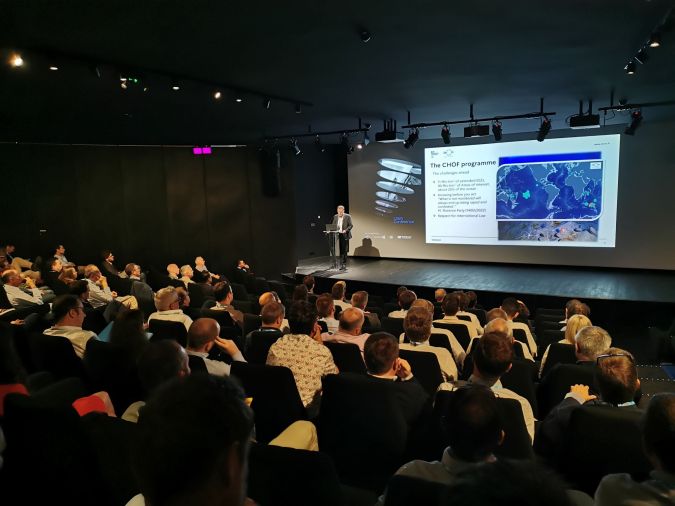The Promise of Autonomous Marine Operations
A Visit to the iXblue 2022 Users Conference
The transition to autonomous marine operations is a promising process in full swing. The advantages of carrying out hydrographic or oceanographic tasks autonomously weigh heavily against the traditional methods. Global climate change and carbon footprint reduction triggered the development of the autonomous technologies and the transition to these technologies continues to help in the battle against these global challenges. However, the process towards increased use of these new technologies also needs to be supported both business-wise and policy-wise. All too often, surveying companies find the business case hard to make, while the pros are quite clear. Regulations also need to be put in place to avoid a Wild West hunt to the bottom of the ocean.
At the iXblue Users Conference, hosted at the iXcampus in Saint-Germain-en-Laye, Ile-de-France, France on 23 June 2022, many of the pros were highlighted by the speakers of the day. They included Dr Mathias Jonas, Secretary-General of the IHO, Rear Admiral (ret) Tim Gallaudet of Ocean STL Consulting, Dr Anna Lim from Argeo and Hendrik de Beuf from DEME and many more. This well-organized conference shed light on the future of autonomous operations in which iXblue’s Drix USV is playing a leading role.

Influencing the Agenda
The conference was opened by Dr Mathias Jonas. In his opening address, Jonas acknowledged that autonomous technology is heavily influencing the agenda of the International Hydrographic Organisation. Not only does the transition to autonomous marine operations make it possible to get more renewable energy; for example, by making it easier to monitor offshore wind parks, but safety at sea is also increasing. For instance, by using uncrewed vessels, there’s no need to send crews out to dangerous places any more. Another advantage, and the growing market for autonomous surveying in any form, is that of a sustainable food supply. Aquafarming, for instance, is growing fast, already providing half of the fish consumed in the world. If 50% of the fish that ends up on a plate comes from aquafarming, it means that less of a drain is being made on natural resources and this will lead to a better climate. Wherever there is pollution, and everybody knows there is a lot, autonomous monitoring is being called into play, with the measurement of microplastics in the water column serving as a striking example.
All of the above are examples of improving things we do already. With autonomous technologies, operators can get to remote places more easily, or speed up the work that needs to be done without putting crews in harm’s way. However, it was the things we are not doing yet, the glimpses into the future, that made delegates at the iXblue Users Conference sit upright in their chairs with a bang! Possible solutions to the crisis that the world is in are always appealing to an audience whose green hearts are beating for the blue world.
Solution
The Norwegian company Argeo is constantly increasing efficiency and data quality, while at the same time reducing CO2 emissions from operations involving infrastructure, offshore wind, oil & gas and deep sea minerals. Dr Anna Lim from Argeo addressed the subject of deep sea minerals.
In 2023, the International Seabed Authority will decide on the rules, regulations and procedures to guide the exploitation in waters outside of the EEZ. The expectations are high. Many minerals and rare metals are now being appropriated by the global economy in large and unsustainable quantities. This is simply because they are in devices almost everybody uses every day; take, for example, lithium for batteries and phones, or even more rare minerals which are used in the same devices in smaller quantities. They come from places on Earth that are hard to reach and this often puts a strain on geopolitical relationships. Scientists have high expectations about the seafloor massive sulfides, polymetallic nodules and crusts that are found along mid-ocean ridges, on volcanic seamounts, or the abyssal plains of the world’s oceans. Harvesting these deep-sea minerals, containing critical metals such as manganese, cobalt and nickel, could solve the exhausting and devastating hunt for the same metals and minerals on land. But this is obviously no easy task as most of them are found at great depths of more than five to six kilometres. And to find them, we still have to survey millions of square kilometres of seabed in order to be able to harvest as efficiently and sustainably as possible. This is where AUVs are coming in: they provide an efficient way to cover large seafloor areas with the highest possible resolution multiphysics data, meaning that they are best suited to carry out the mineral exploitation and mapping surveys. While deep sea mining is not allowed at present, deep sea minerals could make for an alternative source of critical metals. According to Dr Lim, it is very important to base future decisions on factual knowledge that in turn relies on data from exploration surveys. The key principle for any deep-ocean exploration survey can be formulated as multi-dimensional data-driven efficiency, where each survey must provide relevant data of high quality at an optimal areal coverage rate, and with as little impact on the environment as possible. This systematic approach is heavily relying on autonomous underwater technology.
Hendrik de Beuf, chief surveyor with DEME, a Belgian company specialized in dredging, marine engineering and environmental remediation, took up where Dr Anna Lim left off. DEME clearly intends to combat global threats, the rising sea level, the growing world population and the scarcity of natural resources. According to its vision, the search for minerals needs to be carried out as cleanly and sustainably as possible. The demand for metals and earth minerals will only increase. In one of the spots that has been assigned for some exploration, DEME has already tested the harvesting of nodules by an autonomous underwater vehicle with promising results. It goes without saying that DEME is eagerly awaiting updated policy in this new field.

Hurdles
However promising all this may sound, there are still some hurdles to be overcome before the field can make full use of the advantages of autonomous marine operations. A few of them are technological by nature of course, but I’ll leave those to the technicians at fine companies like iXblue, where many engineers are working every day to develop autonomous marine operations into a mature industry. I would like to focus on policy and business in this piece.
The first hurdle to overcome concerns regulations. To avoid the autonomous realm of the oceans becoming a Wild West for deep sea mining and renewable energy, it will be necessary to agree on regulations that will cover issues such as safety, privacy and exploration rights, especially in those areas outside the EEZ. Rear Admiral Tim Gallaudet, who headed up NOAA before his retirement, warned the audience at the iXblue Users Conference of situations where there are no rules and where people do whatever they can to get to the bottom as soon as possible, using means that have not been designed to meet criteria for clean energy, sustainability and efficiency. Gallaudet regularly advocates more regulation with, for example, the American federal government.
Another challenge that needs to be overcome in the near future is that of the gap between the workforce and the deployment and use of autonomous and uncrewed vehicles. At the moment, the workforce has not been sufficiently trained and there is not enough capacity to bridge the gap quickly. This means we cannot make optimal use of autonomous technology. This point needs to be considered by naval and maritime colleges as well as educators from the private sector.
The last point is the business case for autonomous surveying. The margin between revenue and costs, interest and depreciation is often still running thin. For (rental) companies, up front investments are so high that any downtime, be it a surveying job at sea, or simply in the harbour, is too much. More work in the future will not be the problem, so leaving the AUV or USV on the ship, or on the quay, will probably occur less and less frequently. Another part of the solution, besides full-time deployment of the vehicles, is a good and decent price. Too often, governments contract work out for the lowest price. Governments at all levels are still the biggest clients in many of the projects that involve AUVs and USVs. Governments should be good customers, setting an example in doing business. If sustainability is an argument for deploying new technology, it should also be an argument for hiring surveying companies!
The iXblue Users Conference in Saint-Germain-en-Laye shed light on the future of autonomous maritime operations. iXblue brought together a crowd of enthusiastic and passionate ‘tech for a better blue environment’ believers, working both with iXblue and their clients from all over the globe, together with a bunch of high-level influencers, in a beautiful environment. That was a bonus and a joy. It was impossible, of course, to cover all the presentations in this report, but keep track of Hydro International; we’ll keep you up to date. The main takeaway for now is that although some hurdles still need to be overcome, technical, business-wise and policy-wise, the future of autonomous maritime operations is bright and quite promising!

Value staying current with hydrography?
Stay on the map with our expertly curated newsletters.
We provide educational insights, industry updates, and inspiring stories from the world of hydrography to help you learn, grow, and navigate your field with confidence. Don't miss out - subscribe today and ensure you're always informed, educated, and inspired by the latest in hydrographic technology and research.
Choose your newsletter(s)
























